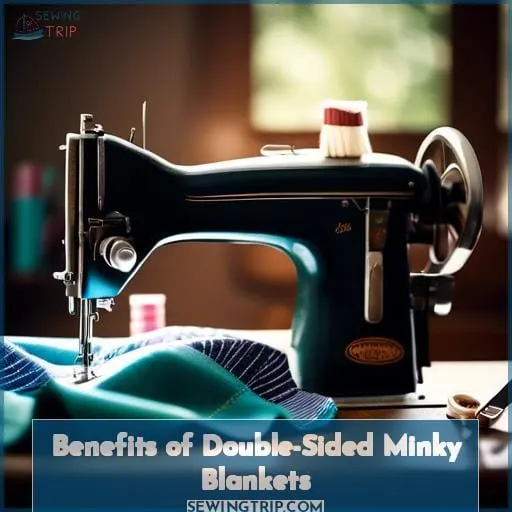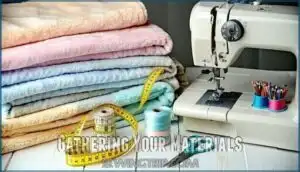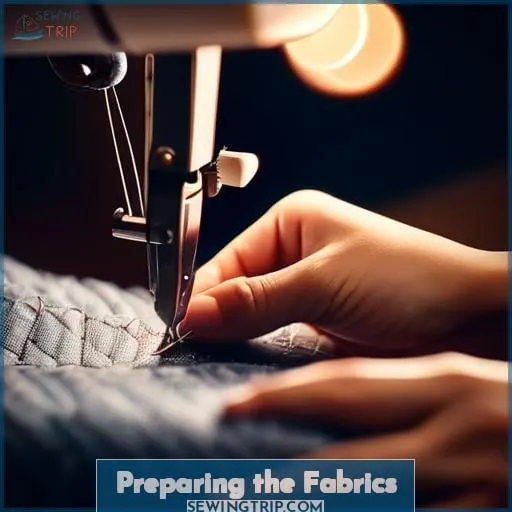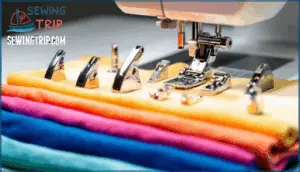This site is supported by our readers. We may earn a commission, at no cost to you, if you purchase through links.

This guide will walk you through the steps to sew a double-sided blanket, combining ease with creativity. You’ll learn how to select fabrics, prepare them for sewing, and execute stitching techniques that ensure a cozy, durable finish.
Let’s dive into this DIY project that’s as rewarding to make as it is to snuggle under.
Table Of Contents
Key Takeaways
- Double-sided minky blankets offer benefits such as comfort, warmth, aesthetic appeal, and they can be personalized gifts that are relatively easy to create.
- Essential materials for making a double-sided blanket include 1 1/2 yards of minky fabric, coordinating thread, and basic sewing supplies.
- Proper preparation of the fabrics involves sizing and cutting the fabrics accurately and pinning them together correctly before sewing.
- The sewing process includes stitching the pieces together, adding ties for easy rolling, employing appropriate stitch techniques for strength, topstitching for enhanced durability, and trimming excess threads for a clean finish.
How to Sew a Double Sided Blanket
To sew a double-sided blanket, you’ll need to place two pieces of fleece right sides together, sew around the edges with a 1/2 inch seam allowance, leaving an opening to turn it right side out, then topstitch to finish.
Benefits of Double-Sided Minky Blankets
Double-sided Minky blankets offer unmatched comfort and warmth, making them a perfect addition to any home.
Their aesthetic appeal and ease of creation also make them an ideal gift for loved ones.
Comfort and Warmth
Dive into the cozy embrace of a double-sided minky blanket, where comfort meets texture.
With your sewing machine and safety pins at the ready, transform minky fabric into a snuggle haven.
It’s warmth in every stitch, a cozy haven in every fold.
Aesthetic Appeal
After basking in the cozy embrace of your creation, let’s jazz it up.
Think bold color combinations and contrast textures.
Dive into pattern matching and sprinkle in unique designs.
With silk curtains, iron, and sewing supplies, your blanket transforms into a masterpiece of comfort and style.
Gift Potential
After reveling in the chic charm of your double-sided blanket, imagine it as a personalized present.
For special occasions, a handcrafted minky or fleece blanket becomes a thoughtful gesture, transforming into a memorable keepsake that warms both body and heart.
Ease of Creation
After gifting warmth and smiles, you’ll find the creation of these blankets a breeze.
With simple instructions, even beginners can whip up a cozy masterpiece in no time.
It’s all about fold-up-and-go convenience, turning time-saving into an art form.
Gathering Your Materials
Choosing the right fabric and gathering your sewing essentials are the first steps in creating a cozy, double-sided blanket.
You’ll need 1 1/2 yards of minky fabric and coordinating thread, along with basic sewing supplies.
Fabric Selection
After reveling in the plush comfort of your future double-sided minky blanket, it’s time to dive into the treasure trove of fabrics.
Selecting the right quality is crucial; you want a fabric that feels like a cloud against the skin. Consider the visual feast of color combinations and the tactile delight of texture contrast.
Keep an eye on fabric cost, but don’t scrimp on luxury. Grab your scissors, preheat the iron, and let’s cut to size and sew along the edges for that roll-up blanket perfection.
Sewing Essentials
Ready to dive into the cozy world of blanket-making? You’ll need to pick your fabric choices wisely—think soft minky in color combinations that scream snuggle time.
Whether you’re crafting a tiny comforter or a king-sized cocoon, personalizing blankets is a cinch.
Grab your ironing board, press those fabrics flat, and get ready to flip, topstitch, and trim your way to a masterpiece.
Preparing the Fabrics
Now that you’ve gathered your materials, it’s time to size and cut your fabrics.
Pinning them together properly will set the stage for a smooth sewing process.
Sizing and Cutting
When you’re sizing and cutting your fabrics, think of it as setting the stage for your cozy creation. Your fabric selection will define the blanket’s personality, so choose colors and patterns that sing to you.
Remember, you’re not just making a blanket; you’re crafting a cocoon of comfort.
- Embrace the warmth with your choice of fabric colors.
- Let fabric patterns express your creative spirit.
- Determine the blanket size for snuggle perfection.
- Cut with precision for a flawless blanket shape.
- Learn how to sew a double-sided blanket and become a cozy craftsman.
Pinning for Sewing
After sizing and cutting your minky fabrics, you’re ready for the next step: pinning for sewing.
Think of pinning as laying down the tracks for your sewing train. Choose your pin types wisely—like selecting the right soldiers for battle.
Organize your pins for easy access and place them about 2-3 inches apart, ensuring they’re perpendicular to the edge. This setup not only makes pin removal a breeze as you sew but also keeps the fabric from shifting.
Sewing the Blanket
Now that you’ve got your materials ready, it’s time to start sewing your double-sided blanket.
You’ll stitch the pieces together and add ties for easy rolling, making it both functional and cozy.
Stitching Techniques
After choosing your blanket fabrics and cutting them to size, it’s time to dive into the stitching. Think of your sewing machine as your trusty sidekick in this creative adventure.
Start with a straight stitch around the edges, leaving a gap for turning. This is where the magic happens—flip that cozy creation right side out.
For tie placement, ensure they’re evenly spaced for a snug roll-up. Mix stitch types for durability, considering fabric weights.
Lastly, employ finishing techniques like topstitching to give your blanket a polished look.
Adding Ties for Rolling
After mastering the stitching, it’s time to add a twist with ties for rolling. This nifty feature transforms your blanket into a portable snug haven.
- Choose Your Ties: Opt for ties that match or contrast beautifully with your blanket. Consider tie material and color for an eye-catching look.
- Measure Tie Length: Ensure your ties are long enough to secure the blanket snugly.
- Strategically Place Ties: Position them for easy roll-up and unroll, enhancing tie durability and functionality.
Voilà, you’re ready to roll!
Finishing Touches
Now that your blanket’s assembled, it’s time to ensure it lasts.
Topstitching adds durability.
Trimming any excess threads keeps your work neat.
Topstitching for Durability
Once you’ve flipped your blanket right side out, it’s time to add the cherry on top: topstitching.
Think of topstitching as the secret sauce that not only secures your masterpiece but also adds a dash of flair.
Grab your topstitching thread and choose from a variety of topstitching patterns to give your blanket that professional edge.
Whether you’re using a basic sewing machine or one of those fancy topstitching machines, this step is your playground.
Experiment with different topstitching techniques and embellishments to make your blanket truly one-of-a-kind.
Trimming and Cleaning Edges
After topstitching for that extra durability, it’s time to give those edges a neat haircut.
Snip away any wild threads that think they’re auditioning for a punk rock band—this isn’t their stage.
For fabric that loves to fray like it’s going out of style, a quick zigzag stitch along the edge will keep it in line.
Corners? Poke them out gently, like coaxing a shy cat from under the bed.
And for a final flourish, consider decorative trimming. It’s like adding sprinkles to your favorite ice cream.
Frequently Asked Questions (FAQs)
Can I mix different types of fabric?
Absolutely, you can mix and match different fabrics to your heart’s content!
Just remember, like a culinary fusion, it’s all about finding the right balance.
So, go ahead, blend those textures and cook up something cozy!
How do I prevent the fabric from stretching?
Like a knight armoring for battle, stabilize your fabric with a walking foot or by lowering presser foot pressure to prevent stretching during your sewing quest.
What stitch length should I use?
For your double-sided blanket, aim for a stitch length of 5 to 3 mm. This sweet spot keeps your fabric from stretching, ensuring a snug, durable finish that’s just right for cozy cuddles.
Can I add batting between the layers?
Curious about adding batting between your double-sided blanket layers? Absolutely, you can!
It’s like sneaking a layer of cloud into your creation, offering extra warmth and a plush feel.
Just imagine the cozy cuddles ahead.
How do I care for my double-sided blanket?
Caring for your double-sided blanket is a breeze. Wash it in warm water with like colors and tumble dry low.
Steer clear of bleach, ironing, or dry cleaning to keep it cuddly and vibrant.
Conclusion
Now, you’re on the brink of completing a project that’s as cozy as it’s charming. Sewing a double-sided blanket has guided you through a journey of creativity and skill.
With your chosen fabrics transformed and the stitches in place, you’ve crafted something truly special. Remember, this guide on how to sew a double-sided blanket isn’t just about making; it’s about creating warmth and joy, stitch by stitch.
Wrap yourself in your accomplishment and cherish the comfort it brings.











